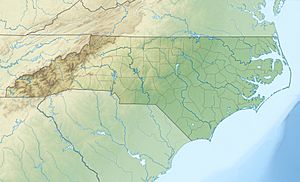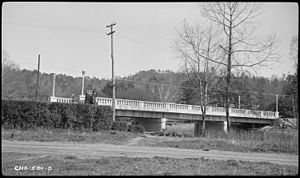Valley River facts for kids
Quick facts for kids Valley River |
|
|---|---|
|
Location of Valley River mouth
|
|
| Other name(s) | Tributary to Hiawassee River |
| Country | United States |
| State | North Carolina |
| County | Cherokee |
| City | Andrews Murphy |
| Physical characteristics | |
| Main source | Tulula Creek divide about 2 miles northwest of Tipton, North Carolina 3,520 ft (1,070 m) 35°15′24″N 083°42′42″W / 35.25667°N 83.71167°W |
| River mouth | Hiawassee River Murphy, North Carolina 1,525 ft (465 m) 35°05′33″N 084°02′22″W / 35.09250°N 84.03944°W |
| Length | 29.57 mi (47.59 km) |
| Basin features | |
| Progression | southwest |
| River system | Hiawassee River |
| Basin size | 117.13 square miles (303.4 km2) |
| Tributaries |
|
| Waterbodies | Hiawassee Lake |
| Bridges | Campbell Terrace (x3), Kadie Lane, Woodhaven Lane, Old US 19, US 19 (x2), Nelson Road, Patterson Lane, US 19-US 129 (x3), Driftwood Lane, Gipp Creek Road, Stewart Road, US 19, Robbinsville Road, Locust Street, Main Street (US 19), NC 141, US 19 (x4), Casino Parkway, Snap On Road, US 19-US 129, Black and Gold Drive, Bulldog Drive, US 19, Tennessee Street |
The Valley River is a river in North Carolina, USA. It flows into the Hiwassee River. The river starts from springs in the Snowbird Mountains in Cherokee County, North Carolina. It flows downhill about 2,960 feet (902 meters) over nearly 40 miles (64 km). The Valley River then joins the Hiwassee River near Murphy, North Carolina.
The Valley River generally flows towards the southwest. A major road, US 19, runs next to the river between Topton and Murphy, North Carolina. At Murphy, the road crosses the river on a small bridge. The area drained by the river, called its watershed, is about 117 square miles (303 square kilometers).
Contents
River Names and History
The Valley River has had different names throughout history.
What Was the River Called Before?
According to the Geographic Names Information System, the river was also known as:
- Konchete River
How the Valley River Formed
The Valley River was shaped by huge geological events over millions of years.
Mountain Building and Rock Formation
The Appalachian Mountains formed during the Paleozoic Era. This was a very long time ago, about 480 million years ago. During this time, the land was pushed up in an event called the Alleghenian orogeny. Before the mountains formed, this area was covered by shallow seas. These seas left behind large amounts of limestone.
The mountain-building process also changed rocks under high pressure. This process is called metamorphism. The Snowbird and Unicoi Mountains near the Valley River have valuable minerals. These include silver, gold, copper, limestone, sandstone, marble, and brown iron ore.
Valley Creation and Rich Soil
Over 480 million years, the mountains slowly wore down due to erosion. The Valley River carved out a wide, flat valley. This process left behind rich, fertile soil, which is great for farming.
Local Minerals and Mining History
Near Marble, North Carolina, there is high-quality marble in different colors. People have been quarrying this marble since the Trail of Tears in 1838–1839.
Near Rhodo, North Carolina, there is a place called Silvermine Creek. People believed there was a small silver deposit there. An old story from 1849 tells about Spanish miners. They were said to have worked there for a few summers, finding a "white metal." The story says the Cherokee people stopped them to protect their land.
Talc, another mineral, has also been mined in Cherokee County since the 1850s.
River Flow at Tomotla
At Tomotla, the Valley River flows at an average rate of about 247 cubic feet per second (7 cubic meters per second) each year.
People and the Valley River
The Valley River area has been home to people for thousands of years.
Early Native American Settlements
Evidence shows that Native American people lived here between 8000 and 1000 BC. About two miles (3.2 km) east of where the Valley River ends, there is the Peachtree Mound. This is an ancient earthwork mound from the Archaic period. It was studied by the Smithsonian Institution in 1933.
Later Native American groups continued to live here. During the Pisgah Phase (from 1000 to 1500), the Valley River was called Gunahita, meaning "Long River." The Cherokee people later called it Konehetee or Konnaheeta, which means Valley River.
Another old mound, the Andrews Mound, is on private land near Andrews, North Carolina. It is thought to have been built during the Qualla Phase (1500 to 1850). The Iroquoian-speaking Cherokee people likely arrived in this area later.
Cherokee Valley Towns
The Cherokee villages along the Valley River and the larger Hiwassee River were known as the Valley Towns. In the 1700s, traders and colonists from South Carolina grouped Cherokee villages by their location. The Cherokee towns of Conoske, Tomatly, Little Telliquo, and Nayowee were all located along the Valley River.
The Cherokee called the place where the Valley River meets the Hiwassee River Tlanusi’yi. This means "The Leech Place," named after a legendary giant leech.
European Arrival and Settlement
Hernando de Soto was the first European to visit this area. He passed through from May 25 to 30, 1540. De Soto's journey followed an old Native American trail, which is now US 19. He likely passed near the Cherokee Valley Towns.
Juan Pardo followed in 1567. He traveled through the area on his way to build a fort near Charlotte, North Carolina.
The first permanent European settlement was a Baptist missionary outpost. It was built near Peachtree, North Carolina on the Hiwassee River in 1817.
Changes in Land Ownership
The Valley River area saw many changes as western North Carolina counties were formed.
- In 1753, the Valley River was part of Anson County, North Carolina.
- In 1768, it became part of Tryon County, North Carolina.
- In 1779, it was part of Rutherford County, North Carolina.
- In 1791, it became part of Buncombe County, North Carolina.
- In 1808, Haywood County, North Carolina was created and included the Valley River.
- In 1828, Macon County, North Carolina was formed from Haywood County and contained the river.
Until 1835, the land around the Valley River belonged to the Cherokee people.
The Trail of Tears
In 1835, the Treaty of Echota gave the land to the state of North Carolina. Starting in 1838 at Fort Butler, the Cherokee people were gathered to be moved to Oklahoma. This forced removal happened under President Andrew Jackson, even though the U.S. Supreme Court had ruled in favor of the Cherokee. This sad journey is known as the Trail of Tears.
In 1839, Cherokee County, North Carolina was created. It now contains the Valley River. A land lottery was held, allowing European settlers to move in permanently.
The town of Murphy, where the Valley and Hiwassee Rivers meet, was founded in 1835. The town of Andrews was founded on the Valley River in 1890 when the railroad came through the valley. Other communities along the river include Marble, Rhodo, and Topton.
The Valley River Today
The Valley River area is still mostly rural and agricultural. The lower parts of the river can be explored by canoe, but there isn't much activity beyond fishing. In Murphy, the Konehette Park (named after the Cherokee word for "valley") is next to the Valley River. It offers a greenway for walking and enjoying nature.
North Carolina has found that some parts of the Valley River and its smaller streams have minor issues. This includes the entire Valley River between Gipp Creek and Hiwassee Lake. Most of these issues are small and come from water running off farms or paved areas.
US 19 runs through the Valley River valley, offering beautiful views of the Unicoi and Snowbird Mountains. Historic parts of Murphy and Andrews have been fixed up, bringing some visitors to the area. There is also a large flea market and fun activities around Hiwassee Lake.




